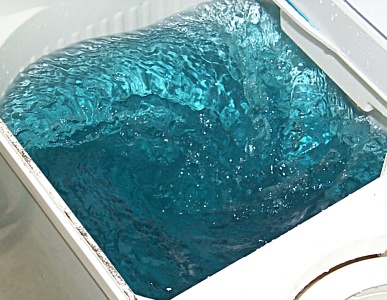 A Sanyo 256T washer forms a whirlpool in the wash tub during the wash cyle. The depth of the center of the whirlpool is proportional to the rotation rate of the water. The following data was recorded for four different spin measurements.
A Sanyo 256T washer forms a whirlpool in the wash tub during the wash cyle. The depth of the center of the whirlpool is proportional to the rotation rate of the water. The following data was recorded for four different spin measurements.
 A Sanyo 256T washer forms a whirlpool in the wash tub during the wash cyle. The depth of the center of the whirlpool is proportional to the rotation rate of the water. The following data was recorded for four different spin measurements.
A Sanyo 256T washer forms a whirlpool in the wash tub during the wash cyle. The depth of the center of the whirlpool is proportional to the rotation rate of the water. The following data was recorded for four different spin measurements.
| Depth of whirlpool/cm |
|---|
| 0 |
| 6 |
| 11 |
| 16 |
| Basic Statistics | |||
|---|---|---|---|
| Statistic or Parameter | Symbol | Equations | Excel |
| Square root | =SQRT(number) | ||
| Sample size | n | =COUNT(data) | |
| Sample mean | x | Sx/n | =AVERAGE(data) |
| Sample standard deviation | sx or s | =STDEV(data) | |
| Sample Coefficient of Variation | CV | 100(sx/x) | =100*STDEV(data)/AVERAGE(data) |
| Statistic or Parameter | Symbol | Equations | Excel |
|---|---|---|---|
| Confidence interval statistics | |||
| Degrees of freedom | df | = n-1 | =COUNT(data)-1 |
| Find a zc value from a confidence level c | zc | =ABS(NORMSINV((1-c)/2)) | |
| Find a tc value from a confidence level c | tc | =TINV(1-c,df) | |
| Calculate an error tolerance E of a mean for n >= 30 using sx | E | =zc*sx/SQRT(n) | |
| Calculate an error tolerance E of a mean for n < 30 using sx. Can also be used for n >= 30. | E | =tc*sx/SQRT(n) | |
| Calculate a confidence interval for a population mean µ from a sample mean x and an error tolerance E | x-E<= µ <=x+E | ||